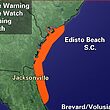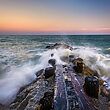With all the news about Hurricane Irene and predictions about where the storm will go, one thing is for certain for people living in coastal towns within the hurricane watch zones: the storm surge is something to be prepared for.
According to the National Weather Services National Hurricane Center, a storm surge poses the greatest risk to life and property. The National Weather Service predicts that much of the South Carolina coast is at a high-risk for a storm surge Friday and Saturday.
So what is a storm surge?
Astronomical tides cause the ocean waters to rise and recede. Edisto Beach residents and locals might notice that from time to time that high tide seems more intense and as though the ocean is going to spill onto Palmetto Boulevard. Sometimes it actually does. Other times, it seems as though low tide is particularly low and sometimes docked boats wind up a little muddy. Both of these occurrences are normal and expected.
But a storm surge occurs when a storm causes the water to rise above its normal levels and causes varying degrees of flooding. Storm surges are created by the strong winds created by a hurricane that push the water toward the shore.
In addition to the surge, the normal ocean currents become dangerously strong and erode beaches. Edistos beach is already a victim of heavy erosion due to normal ocean currents, but every strong storm makes it worse. This erosion does have the capacity to affect the foundations, beach walls, decks, and stairways of homes.
Marinas and docked boats often are damaged due to a storm surge. Keep in mind that the creeks also rise during a storm surge, so beach front residents are not the only ones affected.
Remember to never attempt to drive on a flooded roadway. In addition, some people try to get in the ocean to ride the waves created by the storm, but this is extremely dangerous as the currents and waves can be very strong.






